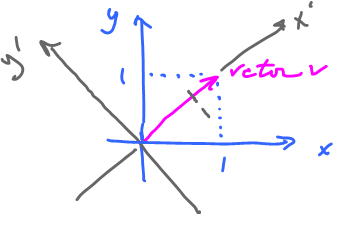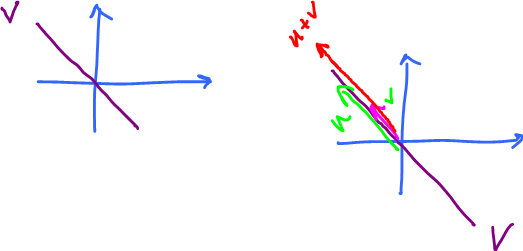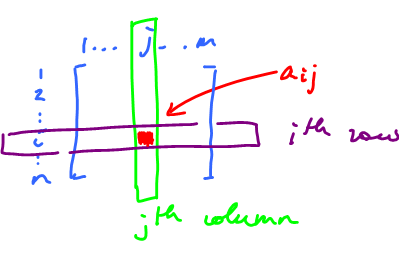This site is being phased out.
Vector spaces: introduction
We start with...
Contents
Real numbers and their algebra
We will make observations -- about numbers -- and extract more specific properties, i.e., theorems about numbers, from these observations. Finally, we forget about numbers and treat these theorems as axioms -- about algebraic entities more general than just numbers.
Example...
Where does this algebra:
- $x+2x=3x$
come from? It comes from arithmetic, observations like this:
- $5+2\cdot 5=3\cdot 5$.
This observation suggests the distributive property of numbers:
- $a(b+c)=ab+ac$.
Let's try it
- $ab+ac = x + 2x$ let $a=x$, $b=1$, $c=2$.
Then
- $ab + ac = x \cdot 1 + x \cdot 2 = x + 2x$.
Turns out we used more than that here. We also used the multiplicative identity:
- $1 \cdot d = d \rightarrow d \cdot 1 = d$.
Only now we apply distributive property:
- $x + 2x = x \cdot 1 + x \cdot 2 = x(1+3) = x \cdot 3 = 3x$.
Other properties:
- Multiplicative commutativity: $ef = fe$
- Associativity: $a + (b+c) = (a+b)+c$ and $a \cdot (b \cdot c) = a \cdot (b \cdot c)$
- Additive identity: $0+a=a+0=a$.
Why isn't on the list?
- $0\cdot a = 0$
Because it's not independent from the rest (and we want to make the set of axioms as short as possible). Indeed we derive it:
- $0a = (0+0)a=0a+0a$, next $0a-0a=0a+0a-0a$, therefore $0=0a$.
The first entity that satisfies the axioms that we discover is ordered pairs of numbers $(x,y)$, i.e., 2-vectors. Geometrically, they are points on the plane:
But that's not important, algebraically! The point is that we can perform some algebraic operations with these entities if we define them properly.
Definition: Define "addition":
- $(x,y) + (a,b) = (x+a, y+b)$.
Exercise. Verify the properties (aka axioms).
What axioms for this can we get from the axioms of real numbers? The following three axioms have analogues.
Associativity for $2$-vectors:
$\begin{align*} ((x,y)+(a,b))+(u,v) &\stackrel{ {\rm def} }{=} (x+a,y+b)+(u,v) \\ &\stackrel{ {\rm def} }{=} ((x+a)+u, (y+b)+v) \\ &\stackrel{ {\rm assoc. \hspace{3pt} twice} }{=} (x+(a+u), y+(b+v)) \\ &\stackrel{ {\rm def} }{=} (x,y)+(a+u,b+v) \\ &\stackrel{ {\rm def} }{=} (x,y)+ ((a,b)+(u,v)) \end{align*}$
What about $3$-vectors $(x,y,z)$, or $n$-vectors $(x_1,\ldots,x_n)$?
Same.
More compact rule (associativity for vectors):
- $(X+A)+U=X+(A+U)$, where $X=(x,y)$, $A=(a,b)$, and $U=(u,v)$.
Note: Often vectors are bold: ${\bf v}$. Elsewhere, they have an arrow: $\vec{v}$ . We don't use this notation here. From context, it should be clear when this is a vector.
What about multiplication?
- $(x,y)(a,b)=(xa,yb)$.
It doesn't make as much sense...
Vectors come from physics, velocities, forces, etc.
$F_1+F_2$ is geometric addition.
$F_1+F_2$ is geometric addition with a coordinate system. In this case, forces are pairs of numbers $F_1=(x_1,y_1)$, where $x_1$ is called the $x$-component and $y_1$ is called the $y$-component.
The physics approach gives us this idea about vectors:
- ${\rm vector} = {\rm magnitude} \& {\rm direction}$.
Exercise: Prove this:
- $F_1+F_2 = (x_1,y_1)+(x_2,y_2)=(x_1+x_2,y_1+y_2)$
To have the algebra of vectors, what else do we need to handle the physics?
What if I want to double the force?
- Geometry: Same direction, twice the magnitude.
- Algebra: Multiply both components by $2$:
$$2(x,y)=(2x,2y)$$ (on the left hand side, the $2$ is a number and $(x,y)$ is a vector).
This is called scalar multiplication, also known as "scalar product": $${\rm number} \cdot {\rm vector}.$$
Exercise: $r(x,y) = (rx,ry)$ is coordinate-wise scalar multiplication.
It's important to remember that pairs of numbers are vectors but vice versa isn't as clear-cut: vectors are converted to pairs differently for each coordinate system chosen.
Let's start with $v=(1,1)$, in the standard system.
Now what if we have another system? Let's try $(x',y')$. Then $v=(\sqrt{2},0)$.
Important point: We want algebra independent from the coordinate system.
Hence our
Coordinate free approach
Definition: A vector space is a set $V$, where two operations are defined:
- addition: $u,v \in V$ then $u+v \in V$,
- scalar multiplication: $r \in {\bf R}$, $u \in V$, then $ru \in V$
(notice multiplication is on the left!).
They satisfy the conditions: for all $u,v,w \in V$, $r,s \in {\bf R}$
- 1. $u+v = v+u$ (commutativity of addition)
- 2. $(u+v)+w = u+(v+w)$ (associativity of addition)
- 3. There is a vector $0 \in V$ such that $0+a=a$ for all $a \in V$ (additive identity)
- 4. For each $a \in V$ there is a vector $-a \in V$ such that $a + (-a) = 0$ (additive inverse)
(note: $-a$ is simply a special name here.)
- 5. $r(u+v)=ru+rv$ (first distributive law)
- 6. $(r+s)u=ru+su$ (second distributive law)
- 7. $(rs)u=r(su)$ (associative law for scalar multiplication)
(note: $rsu$ does not make sense before the previous law)
- 8. $1u = u$ (multiplicative identity)
No subtraction, no cancellation; they come later.
Main idea: A vector space is "closed" under these operations.
To illustrate:
Example: ${\bf Z}$, the integers, is not a vector space, because it is not closed under scalar multiplication. Consider
- $\frac{1}{2} \cdot 3 = \frac{3}{2} \not\in {\bf Z}$.
Consider also: $${\bf R}, {\bf C}, {\bf Q}, {\bf Z}_2.$$
Example: ${\bf Z}_2 = \{0,1\}$ is not closed under addition, but is closed under multiplication. (Wait for Modern algebra: course.)
Example: $(0,\infty)$ is closed under addition, but...
What more do we need? What follows from the axioms?
Special vectors...
- #3. $0$ is a vector. How many are there?
Let's prove it's unique. How?
Suppose there are two, another one called $0'$. Both satisfy #3. Need to show $0=0'$.
By #3, $0+0' = 0'$ and $0' + 0 = 0$, same by #1, implying $0=0'$. Done.
- #4. Similar. Given $a \in V$, is a unique? Yes. Exercise.
Proposition:
- $0v=0$
(on the left side $0$ is a number and $v$ is a vector).
Observe: this is not an axiom!
We can continue on and on... More and more corollaries. Too many to learn them all.
Proposition:
- $r0=0$
(this will justify using: the zero vector).
Try to prove some of these. Rely only on axioms.
Define subtraction and cancellation. Prove some properties.
Proposition: $v-0=v$
$\frac{v}{3}=\frac{1}{3}v$
Specific vector spaces:
- Numbers: ${\bf R}, {\bf C}, {\bf Q}, {\bf Z}_2$ \\
But the main example is...
Euclidian spaces
$\begin{align*} {\bf 0} & \{0\} \\ {\bf R} & {\rm real \hspace{3pt} numbers} \\ {\bf R}^2 & {\rm spaces \hspace{3pt} of \hspace{3pt} pairs \hspace{3pt}} (x,y) {\rm with \hspace{3pt} operations \hspace{3pt}} \\ & & (x,y)+(a,b)=(x+a,y+b); r(x,y)=(rx,ry) \\ {\bf R}^3 & {\rm space \hspace{3pt} of \hspace{3pt} tuples \hspace{3pt}} (x,y,z) \\ \vdots & & \\ {\bf R}^n & (x_1,x_2,\ldots,x_n), x_i \in {\bf R} \end{align*}$
Trick question: Is $\emptyset$ a vector space?
No. Why? It does not satisfy #3: $0 \in V$
Operations:
- $(x_1,x_2,\ldots,x_n)+(a_1,a_2,\ldots,a_n) = (x_1+a_1,x_2+a_2,\ldots,x_n+a_n)$ and
- $r(x_1,x_2,\ldots,x_n) = (rx_1,rx_2,\ldots,rx_n)$.
Verify the axioms. How? Coordinate-wise and component-wise.
Here $v$ is a vector and $x,y,z$ are its "components".
Example: Commutativity for numbers $x+y=y+x$ we know, then commutativity for vectors follows. Same for associativity.
What about #3? What is $0$ in ${\bf R}^n$?
- $0 = (0,0,\ldots,0)$
What about #4? What's $-v$ in ${\bf R}^n$?
- If $v=(x_1,\ldots,x_n)$, then $-v=(-x_1,\ldots,-x_n)$.
Generally, $${\bf R}^n = \{ (x_1,\ldots,x_n) \colon x_i \in {\bf R}, i=1,\ldots,n\}.$$
What about ${\bf R}^{\infty}$?
Is there such a thing? Yes.
$${\bf R}^{\infty} = \{(x_1,\ldots,x_n,\ldots) \colon x_i \in {\bf R}, i=1,2,\ldots \}$$
So, ${\bf R}^{\infty}$ consists of infinite sequences and is not Euclidean.
Can we make this set into a vector space?
How do we define operations?
- $(x_1,x_2,\ldots)+(a_1,a_2,\ldots) = (x_1+a_1,x_2+a_2,\ldots)$ and
- $r(x_1,x_2,\ldots) = (rx_1,rx_2,\ldots)$.
Axioms work out OK (check them all component-wise).
Back to ${\bf R}^2$.
This is the plane, but also space of pairs $\{(x,y) \colon x,y \in {\bf R}\}$.
What else?
Consider
Systems of linear equations
Specifically, $2$ equations and $2$ unknowns: $$\left\{ \begin{array}{rl} x+y=0 \\ x-y=0 \end{array} \right.$$ Substitution solves it.
Note: we deal with homogeneous systems, i.e.m $0$'s for the right hand side.
$\left\{ \begin{array}{rl} x+y=0 \\ x-y=0 \end{array} \right.$ $\rightarrow x=0, y=0 \rightarrow \{(0,0)\} \subset {\bf R}^2$
Interpret the answer in ${\bf R}^2$. $(x,y) \in {\bf R}^2$: the two equations are straight lines and the solution is their intersection.
It's been ${\bf R}^2, \{(0,0)\}$ so far. Now we can create more.
Define $$V=\{(x,y) \in {\bf R}^2 \colon x+y=0\}.$$ This is a vector space!
Observe: $u+v \in V$ and $ru \in V$. Comes from a geometric idea...
Let's prove this algebraically.
Given $(x,y) \in V$, $(a,b) \in V$, we have $x+y=0$ and $a+b=0$ (*).
Is it true $(x,y)+(a,b)=(x+a,y+b) \in V$?
We need to show $(x+a)+(y+b)=0$. Easy. Assuming the axioms work,
$$\begin{align*} (x,y)+(a,b) &\stackrel{{\rm by \hspace{3pt} (*)}}{=} (x+y)+(a+b) \\ &= 0+0 \\ &= 0 \end{align*}$$
Also, $W=\{(x,y) \in {\bf R}^2 \colon x-y=0\}$ is a vector space. And $V \cap W = 0$ is also a vector space.
Observation: A solution set $(x,y)$ in ${\bf R}^2$ of a homogeneous linear equation is a vector space.
Same for systems of equations.
Example. Is $Y = \{(x,y) \colon x \geq 0\}$ a vector space?
No.
Why: $(1,0) \in V$ but $-(1,0) = (-1,0) \not \in V$.
Matrices
An $n \times m$ matrix is a table of real numbers with $n$ rows and $m$ columns.
Example: For $n=2$ and $m=3$, we can look at:
That's matrix addition: $\left[ \begin{array}{ccc} 1 & 2 & 3 \\ 0 & 1 & 2 \end{array} \right] + \left[ \begin{array}{ccc} 0 & 1 & -1 \\ 3 & 5 & 0 \end{array} \right] = \left[ \begin{array}{ccc} 1+0 & 2+1 & 3-1 \\ 0+3 & 1+5 & 2+0 \end{array} \right]$
where the right hand side comes from matching the elements in both matrices with the sign $+$.
And this is how we multiply a matrix by a number:
$3\left[ \begin{array}{ccc} 0 & 1 & 2 \\ 5 & 1 & 3 \end{array} \right] = \left[ \begin{array}{ccc} 3 \cdot 0 & 3 \cdot 1 & 3 \cdot 2 \\ 3 \cdot 5 & 3 \cdot 1 & 3 \cdot 3 \end{array} \right]$
Exercise: Consider the following operations on ${\bf R}^2$:
- $(x,y)+(a,b)=(x+1,y+b+1)$,
- $r(x,y)=(rx,ry)$.
Axioms:
- #1. commutativity $\checkmark$
- #2. associativity $\checkmark$
- #3. additive identity $0=(0,-1) \checkmark$
- #4. additive inverse $?$
Given $v=(x,y)$, is there $-v$ such that $v + (-v)=0$?
Say $-v=(a,b)$. Find these $(x,y)+(a,b)=(0,-1)$, or $(x+a, y+b+1)=(0,-1)$. This is a vector equation. (In this case, $x$ and $y$ are known and $a$ and $b$ are unknown.)
Rewrite coordinate-wise:
$\left\{ \begin{array}{rl} x+a=0 \\ x+b+1=-1 \end{array} \right.$
Solve it: $a=-x$ and $b=-2-y$.
So what? It passes #4. $\checkmark$.
- #5. distributive law
$\begin{align*} r(u+w) &=r((x,y)+(a,b) \\ &=r(x+a,y+b+1) \\ &=(rx+ra,ry+rb+r) \end{align*}$
$\begin{align*} rx+rw &= r(x,y)+r(a,b) \\ &= (rx,ry)+(ra,rb) \\ &= (rx+ra,ry+rb+1) \end{align*}$
Notice there is no match if $r\ne 1$. Therefore #5. fails. $\blacksquare$
Matrices, continued.
An $n \times m$ matrix has $n$ rows and $m$ columns. Notation: $M(n,m)$ is the set of these matrices.
Typically, we use $A$ (capital) for matrix, and $A=\{a_{ij}\}$ is the entry of $A$ at the $i^{\rm th}$ row and $j^{\rm th}$.
Example: $A = \left[ \begin{array}{ccc} 1 & 2 \\ 0 & 3 \end{array} \right]$ then $a_{11}=1$, $a_{12}=2$, $a_{21}=0$, $a_{22}=3$.
Example: $A=\{ a_{ij} \}$, $100 \times 100$, $a_{ij}=i+j$.
The idea behind this notation is like the one behind sequences: $a_n=n^2$ (Calculus 2: course).
Except now we have two subscripts:
$$B=\{b_{ij}\}, 100 \times 100, b_{ij}=i-j+1.$$
Then $A+B=C=\{c_{ij}\}$, where
$\begin{align*} c_{ij} &=a_{ij}+b_{ij} \\ &= i+j+i-j+1 \\ &= 2i+1. \end{align*}$
Proposition: $M(n,m)$ is a vector space with these operations:
- $\{a_{ij}\} + \{b_{ij}\} = \{a_{ij} + b_{ij} \}$
- $r\{a_{ij}\} = \{ra_{ij}\}$
Exercise: What is the connection between $M(n,m)$ and ${\bf R}^k$? $$M(n,m) \longleftrightarrow {\bf R}^k$$
Simple: turn a matrix into a vector:
$\left[ \begin{array}{ccc} 1 & 2 \\ 3 & 4 \end{array} \right] \rightarrow (1,2,3,4)$,
We flatten a table into a string:
What is $k$? $k=nm$.
Exercise: Verify the axioms.
Example: $V = \{A \in M(2,2) \colon a_{11}+a_{12}-a_{21}-a_{22}=0\}$ is a vector space.
$W = \{A \in M(2,2) \colon a_{11}+a_{12}-a_{21}-a_{22}=1\}$ is not a vector space!
Also $U=\{A \in M(2,2) \colon a_{11}^2+a_{12}-a_{21}-a_{22}=0\}$ is not a vector space.
Example: $M(1,m)$ "=" ${\bf R}^m$ in what sense?
$(a_{11},\ldots,a_{1m}) \stackrel{?}{=} (a_1,\ldots,a_m)$, just a string of numbers. Plus, the operations are the same.
Also, $M(n,1)={\bf R}^n$:
$\left[ \begin{array}{ccc} a_{11} \\ a_{21} \\ \vdots \\ a_{n1} \end{array} \right]^T \rightarrow [a_1,\ldots,a_n]$ by "transposition".
Definition: If the elements are flipped about the main diagonal the new matrix is called the transposition. Algebraically, $\{a_{ij}\}^T = \{a_{ji}\}$.










